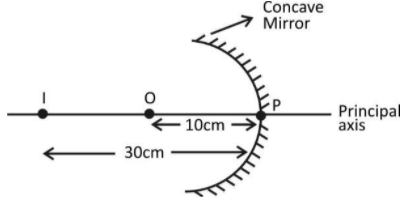
A concave mirror produces three times magnified real images of an object placed at $10cm$ in front of it. Where is the image located?
Answer
574.8k+ views
Hint: We know concave mirror is also known as converging mirror. If the image formed is real then it is always inverted. Also we have to keep in mind the sign conventions while doing the calculations that are all the distance to the left of the pole are taken negative.
Complete step by step solution:

The mirror formula is given as $\dfrac{1}{v}+\dfrac{1}{u}=\dfrac{1}{f}$ and magnification is gives as, $m=\dfrac{height\,\,of\,\,image}{Height\,\,of\,\,object}$
In concave mirror the real image is always inverted so by the question, magnification $m=-3,\,\,also\,\,u=-10cm,\,v=?$
We know that formula for magnification is spherical mirror’s is $m=\dfrac{-v}{u}$
Putting the values of $m=-3$ and $u=-10\,\,in\,\,m=\dfrac{-v}{u}$,
Therefore, \[-3=-\dfrac{v}{(-10)}\]
$v=-30cm$
I$\to $ Image
O$\to $ Object
P$\to $ Pole
Note: Basic sign convention for the spherical mirror are
1. If a virtual image is formed (i.e. behind the mirror) then \[v\] is positive.
2. If a real image is formed (i.e. in front of mirror) then \[v\] is negative.
3. Object distance \[u\] is always negative in the case of a spherical mirror as it is on the left side of the mirror.
4. Focal length of the concave mirror is negative. It is because focus is in front of mirror
5. Focal length of the convex mirror is positive. It is because focus is behind the mirror.
6. In magnification formula of $m=\dfrac{-v}{u}$ for spherical mirrors, if \[m\] is positive, it means image formed is virtual and erect and if \[m\] is negative it means image formed is real and inverted.
Complete step by step solution:

The mirror formula is given as $\dfrac{1}{v}+\dfrac{1}{u}=\dfrac{1}{f}$ and magnification is gives as, $m=\dfrac{height\,\,of\,\,image}{Height\,\,of\,\,object}$
In concave mirror the real image is always inverted so by the question, magnification $m=-3,\,\,also\,\,u=-10cm,\,v=?$
We know that formula for magnification is spherical mirror’s is $m=\dfrac{-v}{u}$
Putting the values of $m=-3$ and $u=-10\,\,in\,\,m=\dfrac{-v}{u}$,
Therefore, \[-3=-\dfrac{v}{(-10)}\]
$v=-30cm$
I$\to $ Image
O$\to $ Object
P$\to $ Pole
Note: Basic sign convention for the spherical mirror are
1. If a virtual image is formed (i.e. behind the mirror) then \[v\] is positive.
2. If a real image is formed (i.e. in front of mirror) then \[v\] is negative.
3. Object distance \[u\] is always negative in the case of a spherical mirror as it is on the left side of the mirror.
4. Focal length of the concave mirror is negative. It is because focus is in front of mirror
5. Focal length of the convex mirror is positive. It is because focus is behind the mirror.
6. In magnification formula of $m=\dfrac{-v}{u}$ for spherical mirrors, if \[m\] is positive, it means image formed is virtual and erect and if \[m\] is negative it means image formed is real and inverted.
Recently Updated Pages
Master Class 12 English: Engaging Questions & Answers for Success

Master Class 12 Economics: Engaging Questions & Answers for Success

Master Class 12 Social Science: Engaging Questions & Answers for Success

Master Class 12 Maths: Engaging Questions & Answers for Success

Master Class 12 Chemistry: Engaging Questions & Answers for Success

Master Class 12 Business Studies: Engaging Questions & Answers for Success

Trending doubts
What are the major means of transport Explain each class 12 social science CBSE

Which are the Top 10 Largest Countries of the World?

Draw a labelled sketch of the human eye class 12 physics CBSE

Explain sex determination in humans with line diag class 12 biology CBSE

The pH of the pancreatic juice is A 64 B 86 C 120 D class 12 biology CBSE

Explain sex determination in humans with the help of class 12 biology CBSE




